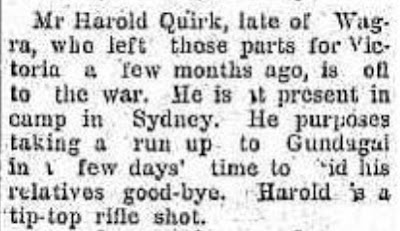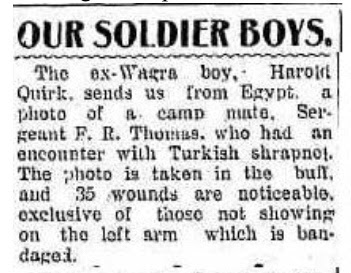Today’s post involves my first cousin four times removed Harold Augustine Quirk. Harold was born in 1885 the son of Thomas Quirk and his wife Kate née Cullen (see post here for more information on this couple). On the 23rd October 1906 at St. Patrick’s church Albury he married Elizabeth Agnes Murray (also known as Letty). They lived at Wagra until 1914 when he sold up the family property and moved his family to Melbourne. On the 16th October 1914 Harold enlisted in the Australian Army with the 6th Australian Infantry Battalion, Service No. 3168.
Transcript:
 |
| Source: Trove. All ABOUT PEOPLE. (1914, November 11). The Gundagai Independent and Pastoral, Agricultural and Mining Advocate (NSW : 1898 - 1928), p. 4. Retrieved from http://nla.gov.au/nla.news-article122205040 |
Transcript:
Mr. Harold Quirk, late of Wagra, who left those parts for Victoria a few months ago, is off to the war. He is at present in camp in Sydney. He purposes taking a run up to Gundagai in a few days’ time to bid his relatives good-bye. Harold is a tip-top rifle shot.
 |
Source: Trove.
|
Transcript:
Lieutenant Harold Quirk, late of Wagra, who has joined the Expeditionary Force for the front, paid a visit to Gundagai last week.
As Harold was a private not a Lieutenant at this time according to his military file, I am not sure how they got this information wrong (inflation or error ?). According to his enlistment papers he had served for five years in the local reserves until the troop was disbanded and maybe they accorded him the incorrect rank due to past local activities.
Acting Corporal Harold Augustine Quirk left Australia from Melbourne on the 29th September 1915 aboard the RMS Osterley (see photograph below from Melbourne in 1917). He left behind in Melbourne his wife Letty and five children Harold, William, Thelma, Myra and Gordon. The children ranged in age from about eight years down to one month old, so Elizabeth would certainly have had her hands full!
 |
| Source: Australian War Memorial Collection Josiah Barnes collection of First World War negatives and prints. Retrieved from https://www.awm.gov.au/collection/PB0793/ |
 |
| Source: Trove. OUR SOLDIER BOYS. (1916, January 13). The Gundagai Independent and Pastoral, Agricultural and Mining Advocate (NSW : 1898 - 1928), p. 4. Retrieved from OUR SOLDIER BOYS. (1916, January 13). The Gundagai Independent and Pastoral, Agricultural and Mining Advocate (NSW : 1898 - 1928), p. 4. Retrieved from http://nla.gov.au/nla.news-article122194983 |
Transcript:
OUR SOLDIER BOYS.
The ex-Wagra boy, Harold Quirk, sends us from Egypt, a photo of a camp mate. Sergeant F.R. Thomas, who had an encounter with Turkish shrapnel. The photo is taken in the buff, and 35 wounds are noticeable, exclusive of those not showing on the left arm which is bandaged.
 |
| Source: Trove. IN THE RANKS. (1916, January 24). The Gundagai Independent and Pastoral, Agricultural and Mining Advocate (NSW : 1898 - 1928), p. 3. Retrieved from http://nla.gov.au/nla.news-article122198647 |
Transcript:
“I saw Dug. Carr and Harold Quirk the other night in Cairo. I never dreamt of seeing Harold Quirk here, and I hardly knew him, and he hardly knew me. Of course, I have grown a bit of a ‘mo,’ and that makes a lot of difference.
It was hardly surprising that Harold looked different to his former Darbalara neighbor Jack Crane. January 1916 was not a good month for Harold, with him having a number of entries on his Active Service Casualty form in his personal military file (see here). First he was discharged on the 10th January 1916 from the 4th Aux hospital in Cairo after having mumps. Then on the 14th January 1916 he was admitted to the 1st Auxiliary Hospital at Heliopolis. Then finally on the 28th January 1916 he embarked to Australia on board the Kanowna for discharge due to Epilepsy.
 |
| Source: Australian War Memorial. Her Majesty's Hospital Ship Kanowna. - Retrieved from https://www.awm.gov.au/collection/C2097008 |
 |
Source: Trove.
|
Transcript:
Wounded Men Return.
BY S.S. KANOWNA.
MELBOURNE, Friday.
Most cheering to the men was the very cordial welcome given this morning to the soldiers who returned from the front by the hospital ship Kanowna. There were on board the vessel 125 Victorians, 49 South Australians, and 18 Tasmanians.
Disembarkation took place at the Port Melbourne pier at 11 o’clock, and the men were conveyed in motor cars through Port and South Melbourne and the city to the Base Hospital. The men were very cheerful, and as they were being motored along the streets many of them smoked cigarettes presented to them as they were leaving the pier by ladies of the welcoming committee.
The ladies also handed to the soldiers floral bouquets, with which they decked their tunics and hats.
The reception committee had festooned the pier gate with Australian foliages, and the flags of Britain, France, Japan and Australia waved above the greenery. Large crowds of people lined the streets, and flags flew from many buildings.
It is expected that the next party of wounded soldiers returning to Victoria will disembark at 10a.m. On Monday.
 |
Source: Trove.
|
Home Again
An ANZAC returns.
Harold Quirk, the first Wagra boy to go to the war, arrived back unexpectedly in Gundagai on Wednesday morning. He is on the sick list, and came over from Egypt in the hospital ship Kanowna, which arrived at Melbourne on Monday. Harold was one of 32 of his company that put in the last days at Anzac. “Out of the 32 of us who went to the Dardanelles,” he says, “only 12 of us returned. We were only 16 days there, but they were days full of excitement. I was nearly ‘outed’ once - a shell knocked down a sandbag parapet and I was one of those buried under it. When I was got out, it was nearly a case of ‘Up went the donkey,’ but I pulled round and was sent to Malta to recuperate. I have since been suffering badly, and doubt if I will ever be fit to return.
“ I saw Jack Isaac a few days before I left - he then looked well. Sherdy Gardiner is blooming - he is one of the greatest ‘characters’ that Australia has at the front. He is quite portly, and ‘as happy as Larry.’ Little Bob Isaac was killed by shrapnel - a bullet caught him in the jugular vein.
“Many extraordinary things have I seen. One day a Gundagai lad was out of the trenches, cutting boxes to boil his tea, when the Captain roared at him, ‘Come in out of that you d- fool, or the shrapnel will get you!’ The Gundagai boy shouted back, ‘D- it’ I will till you give us back our rum ration you took from us!’ The reply tickled the captain’s fancy so much that he immediately capitulated.
“We knew little of what was doing, but I don’t think that the Germans will ever try to take the Sues Canal. If they do, - well I can’t say too much, but believe me the Suez will never pass out of British hands.”
Sergeant Harold Augustine Quirk was medically discharged from the Australian Army on the 9th May 1916. On the 11th October 1916 his War Pension Claim was approved dated from the 10th May 1916. Harold was granted a fortnightly pension of 15/ per fortnight, his wife Elizabeth granted 7/6 per fortnight, son Harold granted 5/ per fortnight (his Mother was trustee), son William granted 3/9 per fortnight (his Mother was trustee), daughter Thelma granted 2/6 per fortnight (her Mother was trustee), daughter Myra granted 2/6 per fortnight (her Mother was trustee) and son Gordon was granted 2/6 per fortnight (his Mother was trustee).
 |
Source: Trove.
|
Transcript:
Trooper Harold Quirk, who, returned from the front last month; has received his discharge from the military forces, and has secured a position as ledger-keeper in the Metropolitan Board of Works, Melbourne. Harold writes, that he is feeling fairly well, but is a little shaky and slightly deaf.
Harold and Letty divorced in 1926. After living in many different locations Harold finally settled in Sydney and it was there that Harold died in 1956. He was buried at the Eastern Suburbs Memorial Park (see here).
Comments
Post a Comment